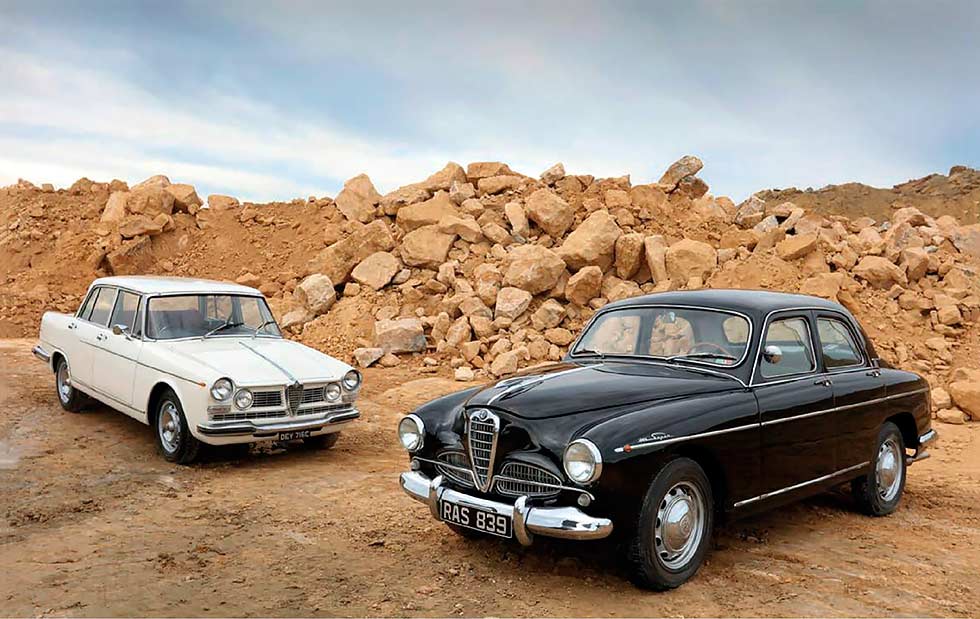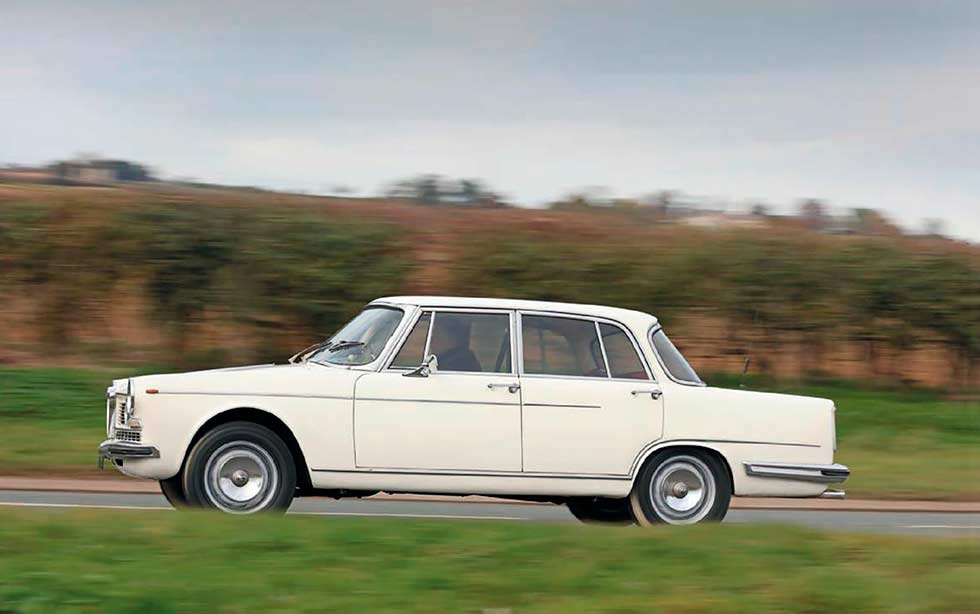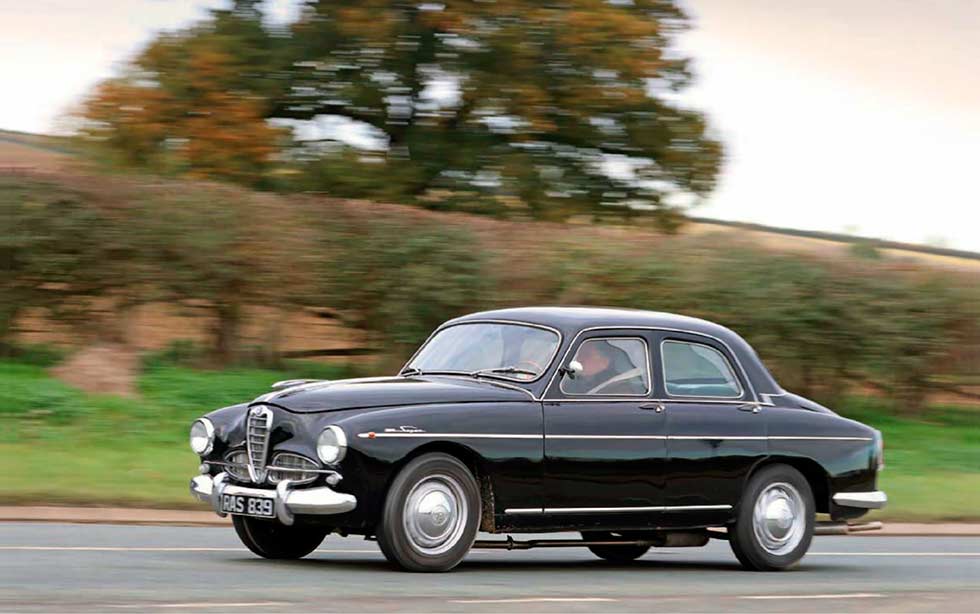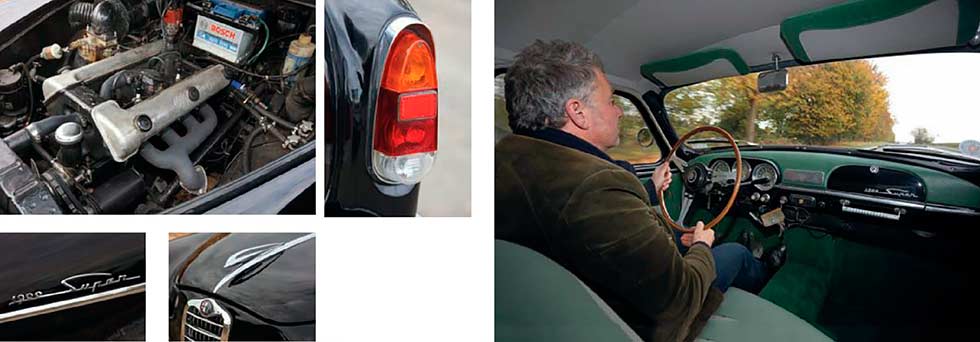
Old habits in a brave new world. Alfa 1900 and 2600: Milan’s contrasting post-war saloons. Alfa’s boom and bust Buckley compares the brilliant 1900 with the overlooked 2600. Car makers needed to rapidly adapt in post-war Europe. Martin Buckley explains why Alfa’s 1900 scaled the heights yet its 2600 sank without trace. Photography James Mann.
The plump, black 1950s saloon shown here is the most significant post-war Alfa Romeo of all, even though it might not look like it. Had it lacked the vision to build this car, Alfa, like dozens of others, might just be an interesting footnote in history. After decades of producing six- and eight-cylinder exotica in rarefied handfuls, the 1900 saloon was the moment Portello went in search of volume sales in a tougher post-war world. Bolstered by $2.1million from the Marshall Plan, the firm was able to invest in the plant and machinery to build a modern car on a large scale for the first time.

Sharper-edged 2600 is clearly a product of the 1960s rather than the previous decade. 1900 formed basis for a number of coachbuilt specials.
The unprepossessing 1900 skilfully combined modern features with Alfa tradition in a contemporary- looking four-door family car that was within the grasp of the middle classes.
This 80bhp, 90mph five-seater was designed to be built at the rate of 500 a month. It was coil sprung all round, eschewing swing arms at the rear for a well-located live axle. Another break from tradition was that the 1900 was Alfa Romeo’s first left-hand-drive car. It was also the last to be offered in ‘chassis’ form. The 1900 would prove to be an absolute gift to the Italian coachbuilding industry in perhaps its most prolific period, and the various ‘Sprint’ models from Touring, Pininfarina plus many others have tended to hog the 1900 limelight.
The saloons might not be as sexy but in a way they are more interesting. Certainly the correctness of the 1900 concept is reflected in the sales figures: 7600 cars in the first three years (or vastly more than the firm built throughout the entire 1930s and ’40s) and a total of 17,390 saloons by the end of production in 1959.

The 2600 makes all the right noises and performs briskly. Above right: bold script; twin carbs for allalloy ‘six’; twin-headlamp front with trademark grille.
The first austere-looking prototype was shown to the press in May 1950 but the public launch was at the Paris Salon in November. In 1951, that 1884cc model was joined by the 1975cc Ti (Tourismo Internazionale), which – for an additional £57 – had a twin-choke Weber, upped the power to 93bhp and took the top speed over 100mph. Three years later, a Ti Super variant with twin Solex carburettors, higher compression and bigger valves raised the output to a full 100bhp. At around the same time, all versions got a better-located rear axle.
The 1900 was Alfa’s first four-cylinder car for a generation but there was always an expectation that it would be supplemented (or replaced) with a six-cylinder model. In fact, the prevailing commercial pressure was to first produce a smaller, lighter and cheaper definition of the 1900 concept; posh versions could wait. This was the era of the ‘boom economico’, during which a new Italian middle class had money to spend for the first time. The 1900 had proven the business case for a bourgeois model to take on cash-strapped Lancia, so Alfa cashed in with an even more populist range in the form of the nifty 1.3-litre Giulietta of 1955.

Above: neat tail-lights in de-finned rear end. Left: visibility is superb in the 2600’s airy cockpit. Note the strip speedo.
From that moment, the success of the Giulietta and its variants began to eclipse the 1900, yet psychologically there was still a need to produce a ‘big’ Alfa. The notion of a ‘six’ never quite went away, but the model that links the 1900 and 2600 is the even more obscure Type 102 2000 Berlina. Based on a longer wheelbase, it was an attempt to update the 1900 idea with a more fashionable body, its fins framing a squared-off bootlid. It had five speeds, too, but was really just a holding operation while a sixcylinder car was made ready for production.
That finally arrived in the form of the 1962 2600 Berlina, a direct descendant of the 2000 (but de-finned and tidied up) and in many ways a car that would prove to be as irrelevant as the groundbreaking 1900 was important.
Why? Because it just didn’t sell. Through to 1968, Alfa built a derisory 2092 of them, making the unloved and nearly forgotten Tipo 106 2600 saloon the rarest of all truly post-war four-door Alfas. It even suffered the indignity of being outsold by specialist Bertone Sprint coupé and Touring-bodied convertible variants. Only the 2600 Zagato and the bizarre OSI-bodied 2600 De Luxe are less numerous than the Berlina.
Twelve years earlier, the 1900 was being fêted as a truly outstanding Italian saloon of its era. Its twin-cam engine was one of the world’s great production units – an efficient short-stroke design with sodium-filled exhaust valves in large combustion chambers and a rugged five-bearing crankshaft that meant it wouldn’t fly apart if held for long periods at high revs.
Here was a sports-car engine in a restrained saloon, from which motorists could extract real performance because the 1900’s unitary body – a first for Alfa – was relatively light.
Although the saloon was, in theory, sold in Britain, I’d never encountered one before clapping eyes on our featured example. Quentin Butler’s 1956 Super was restored in 1990 and spent the first 47 years of its life in Northern Italy. It was imported to the UK in 2003 by Alfa specialist John Williams, and long-time enthusiast Quentin bought it in 2007. He’s gone through the car with new locks, period-style seatbelts, electronic ignition and an alternator to replace the dynamo. The most challenging task has been the rebuilding of the steering box.
“I use it for local trips.” he explains, “although I did take it to Leuven in Belgium last year. It covered about 1000 miles over the course of five days with no problems at all.”
Outwardly, its monolithic looks are generic early-to-mid-’50s, with small windows, fullframe doors and a tall bonnet line topped by a lethal-looking ornament. From the rear, the 1900 could be a Peugeot 403 and often gets mistaken, says Butler, for a Volvo Amazon. He suspects that the rear light units – a larger vertical type on this 1900 Super – are not quite as per original. They are, however, marked ‘Altissimo’ so they’re at least from the right country.

Performance from Super variant is impressive even today. Above left: elegant chromed details; twin-cam ‘four’ served Alfa Romeo for years afterwards.
The interior is similarly austere, with the cloth seats favoured in more genteel Italian Berlinas and a dashboard that has the typically strippedback aesthetic of 1950s European saloons.
The seats are bouncy benches that would doubtless accommodate the claimed six emaciated, chain-smoking post-war Italians but would prove snug for today’s chunkier humanity. The long, deep boot would take all of their luggage, though, and you can see why the unpretentious 1900 was popular with the Italian police. One eccentric touch is that the fuel filler is in the boot, which confuses people at petrol stations.
Driving the 1900 Super, you are constantly reminded of that damning phrase ‘keeps up with modern traffic’. In fact, this car really does. Its engine is smooth and willing and the ratios in the four-speed gearbox are such that you have useful acceleration to more than 50mph in second and almost 75mph in third.
At first, I took the stubby column shift to be the indicator stalk. With 19 links, there’s plenty of opportunity for play but, once you find your way around it, the change verges on the nifty. The generous drums need to be heaved on to pull up the 1900, but it stops square. The heavy steering similarly dates the car, at least at low speeds, with enough heft required to mean that manoeuvres have to be planned in advance.

Above: vertical tail-lights in small ‘fins’; basic cabin features bench seats – it was claimed in period that there was room for six.
You have to keep reminding yourself this is, in effect, a 60-year-old car built to a 70-year-old design. With that in mind, you then marvel at the suppleness of the ride, plus the 1900’s assured stride through corners as the steering lightens and feels pleasingly firm and direct.
If Butler is now well versed in the ways of the 1900, then Jeremy Wilson is just starting out on his adventure with his 2600 saloon, which he bought last summer from South Africa. It’s one of less than 500 right-hooker Berlinas built.
“I wanted a four-seater classic to take my family out in that I could drive 100 miles and not leave me crippled,” he says. “I like Italian cars, and the choice was between a Lancia Flaminia and a 2600: the Alfa came up first.”
After a tricky importation experience, Wilson is still sorting through the snag list on a car that is, in essence, rust-free. He thinks there is only one other 2600 Berlina in the UK but has found three or four for sale across Europe.
The 2600 Berlina came in two series, the earlier type having a bench seat and column change. Later cars, such as Wilson’s, tend to come with a central floor change and individual front seats in cloth or plastic, although I have seen pictures of floor-change cars with the bench seat. There’s an integrated ribbon speedometer and rev counter in an imposing binnacle plus such luxuries as a hand throttle and fan motors front and rear to demist the screens. It panders to the Italian ’60s obsession with warning lamps, with red tell-tales for the choke and demisters. Under the bonnet, there is a lot more going on in terms of electrics (12 fuse-protected circuits) and heater ducting, but the twin-cam architecture of the straight-six powerplant is visibly similar to the 1900’s ‘four’.
As with its sibling, it has floor-hinged pedals and a huge boot. Another link with the older car is the laborious maintenance schedule, with 16 grease points to think about every 2500 miles. Alfa had increased this to nearly 4000-mile intervals on the smaller cars by the early 1960s.
As standard, the saloons came on twin Solex carburettors with primary and secondary chokes, the latter being opened progressively in the interests of refinement and fuel economy. This one, however, has acquired a set of Webers at some point. It sounds magnificent and, presumably, fuel economy has gone out of the window although Wilson has not been far enough in it to find out – and probably doesn’t care anyway.
The first impression is that the six-cylinder car is much faster (which you’d expect) and feels a lot less gloomy because the window area is so huge. It also trumps the 1900 in having five speeds and Girling front discs. But while the 2600 stops better, to some extent the odd ratios in the pleasant gearbox negate the advantage.
First is so low that you get into second almost immediately and, at 18mph per 1000rpm in top, it’s geared exactly the same as the 1900. In fact, you forgive it all this because the engine is so sweet and tuneful, singing freely to 6000rpm, yet with enough torque that you rarely have to drop below fourth. It’s one of those cars that undoubtedly sounds faster than it is, yet there’s a solid shove to the way the 2600 picks up in second and third, and an impressive sustainability to the way it pulls in fourth and fifth.
Apart from the light, powerful brakes, the 2600 is a pre-servo-assisted car with weighty steering that you put your shoulders into but which frees up above walking pace. But if it is not quite the wieldy sports saloon, then neither is the 2600 a barge. It is stable and accomplished when driven ambitiously, quite happy on those narrow tyres with a ride that is firm but unperturbed.
Age and sheer rarity lend enchantment to the 2600. It was a car that suffered not so much at the hands of its rivals but in comparison to younger, smaller models in its own family. The increasing excellence of the four-cylinder Alfa Romeos made a nonsense of the 2600’s inflated price tag and sense of self-importance. You might think it looks stylish today (I do) but nobody could pretend that Portello’s cubist four-door styling themes scaled up comfortably to its flagship car.
But when it comes to big cars, memories are short in Milan – the boxy Alfa 6 was an executive- saloon disaster of similar proportions.
In fairness, the 1900’s task was in many ways easier than the 2600’s – there were fewer new cars competing for buyers’ attention in a postwar sellers’ market starved of new products. This practical saloon was an object lesson in how to move downmarket (and make profits) without squandering your reputation.
The important thing to remember is that the unassuming 1900 Berlina created the engineering template for every successful Alfa saloon – and most of its sports cars – for the next 20 years: two camshafts, inclined valves and four lusty cylinders. All in models that were straightforward in concept but refined in detail and with an emphasis on driver appeal.
‘IN MANY WAYS, THE 2600 WOULD BE AS IRRELEVANT AS THE 1900 WAS IMPORTANT’
TECHNICAL DATS ALFA ROMEO 1900 SUPER
Sold/no built 1950-’1959/17,390
Construction steel monocoque
Engine iron-block, alloy-head, dohc 1975cc ‘four’, Solex carburettor
Max power 93bhp @ 5400rpm
Max torque 96Ib ft @ 3000rpm
Transmission four-speed manual, RWD
Suspension: front wishbones and upper link rear live axle, radius arms, triangulated link; coil springs f/r
Steering Marles worm and roller
Brakes finned alloy drums
Length 14ft 6in (4419mm)
Width 5ft 3in (1600mm)
Height 4ft 10in (1473mm)
Wheelbase 8ft 7 ½ in (2628mm)
Weight 2578Ib (1169kg)
0-60mph 17.1 secs
Top speed 102mph
Mpg 18-25
Price new £1300
Now £20,000+
TECHNICAL DATS ALFA ROMEO 2600 BERLINA
Sold/number built 1962-’1968/2092
Construction steel monocoque
Engine all-alloy, dohc 2582cc straight-six, twin carburettors
Max power 130bhp @ 5900rpm
Max torque 148Ib ft @ 3400rpm
Transmission five-speed manual, RWD
Suspension: front wishbones, anti-roll bar rear live axle, radius arms, triangulated link; coil springs f/r
Steering worm and roller
Brakes discs front, drums rear
Length 15ft 6in (4724mm)
Width 5ft 7in (1702mm)
Height 4ft 10in (1473mm)
Wheelbase 8ft 11in (2717mm)
Weight 3100Ib (1406kg)
0-60mph 13 secs
Top speed 108mph
Mpg 18-24
Price new £2300
Now £15-20,000
{CONTENTPOLL [“id”: 93]}





